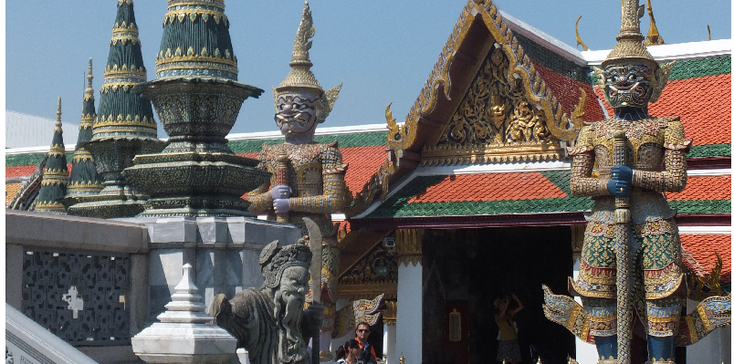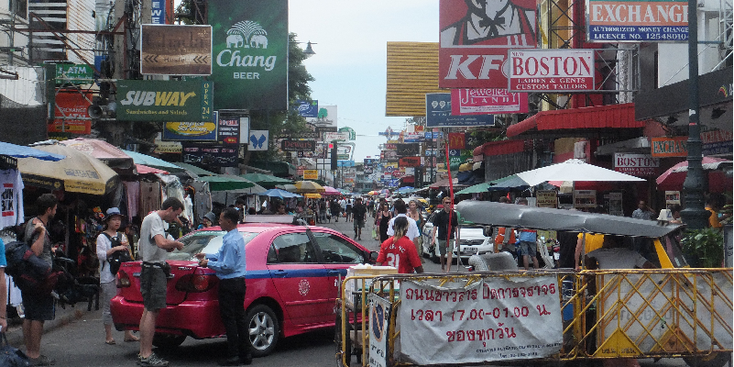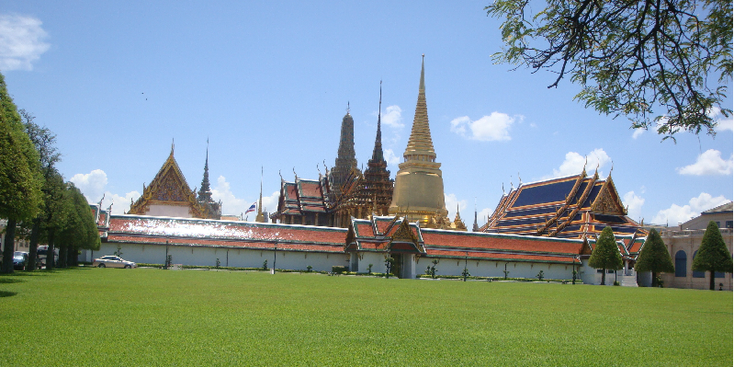Bangkok
Places of Interest - Thailand


introduction
The city of Bangkok, capital of Thailand, is located on the east bank of the Menam river close to the Gulf of Thailand. It is by far the largest and most important city in the country where everything starts and ends. Bangkok is nowadays a modern Asian metropolis with everything that goes with it; high mirror buildings, flashy neon signs, wide busy roads with the latest Japanese cars and all bling-bling.
But Bangkok is also still an Asian city with a lot of culture in the form of the most beautiful temples, culminating in the golden towers of the Grand Palace. The dark and erotic tinted streets like Soi Cowboy and the warm neighborhood of Patpong to the snake farm, Thai boxing, massage salons, cooking courses, department stores and Chinatown. The population of Bankok is as diverse in composition as the architecture, food and style. Besides Thai from all parts of the country, there are also many Chinese, immigrants from India and many expats.
At the end of the 20th century and the first years of the 21st century, Bangkok was among expats in Asia and known around the world as the entertainment city. This was due to Bangkok's varied nightlife: many restaurants, discos and other places of entertainment. The city can be filthy, busy, lively, active and even anxious. Bangkok a city of extremes.
highlights

Wat Phra Kaew and The Grand Palace
The former royal palace and adjacent temple with the emerald Buddha is probably the most famous and largest attraction in Bangkok. The complex appropriated in 1782 when Bangkok became the capital, consists of more than 100 buildings and the motto is sooner or later to go with the heat and the crowds.
You need at least 2 hours to thoroughly go through all the buildings and attractions to get an idea. The part of the complex you are going to visit is in a corner and consists of, among other things, the temple with the green emerald Buddha surrounded by chedi's and yaksha (mythical giants), peaks, towers, golden roofs and temples, all surrounded by a white stone wall that is full of beautiful murals about the history of Thailand.
The architecture is of the old Bangkok style and is unique in the world. Today the palace is no longer used daily by the king but only at special occasions. You can also take a look at the Emerald Buddha and weaponry museum as well as the Borombhiman and Amarindra hall and other surrounding buildings.
ENTRANCE: 500 Baht (2014).

Wat Pho and Wat Arun
Next to the complex of Wat Phra Kaew and the Royal Palace lies the temple complex of Wat Pho. It contains the largest number of Buddha statuettes and the largest reclining Buddha statue worldwide.
The reclining Buddha, the highlight of this temple is no less than 46 meters long and 15 meters high; it presents Buddha's death to the hereafter - the Nirvana. Outside are a large number of stupas representing the different kings. This complex also includes the apprenticeship headquarters for traditional Thai medication, including massage.
Together with Wat Phra Kaew and Wat Pho the temple of Arun is counted among the earliest temples in the history of Bangkok. Located on the other side of the Chao Phraya river, the 82 meter high Khmer tower is the sign and main site of the complex. The construction of the Prang (tower) began in the first half of the 19th century and contains a variety of mosaic of Chinese porcelain and wall drawings.

Floating market
A trip to one of the floating markets is actually a "must-see" for a visit to Bangkok. In the past, many salesmen rowed around in wooden boats loaded with exotic fruits and vegetables decorated with straw hats against the sun. All life at that time went over the water here and the waterways were the most efficient way to reach each other.
Much has changed in the 20th century. Channels have become roads, the boats have been replaced by cars, motorbikes and trucks and the customers are not local people but tourists. The Damnoun Saduak floating market is nowadays more a tourist market than a local affair. Nevertheless, there are still 80 channels in the region and you get (despite the horrible high number of daily tourists) an impression and a feeling in all this how it should have been.
Other attractions:
- MBK (department store), Ban Baht (the monks' bowls village) Chinatown, Thai boxing stadium (see below – general information), amulets-market and the snake farm.

history
Bangkok started as a small trading center and as a port for the city of Ayutthaya, which was the capital until it was buried and destroyed by Burma in 1767. The empire was fragmented and a new location for a new capital was sought. At Thonburi, on the other side of the river near Bangkok, a temporary capital was established because it was (strategically) close to the sea.
In the beginning it consisted only of stilthouses and houseboats because of the changing tide during the seasons. In 1782 King Rama I had a palace built on the island "Rattanakosin" near the river. He made Bangkok the capital, and changed the name to Krung Thep.
In the west, however, the old name of the city is still used. In the late 19th century, the city was modernized quickly when European technologies went East. During the Vietnam War, Bangkok became dangerous not only because here the Americans came to rest (and relax) in the many "go-go" bars and brothels. In the 80s and 90s the high residential towers came and the city became an Asian metropolis comparable to Singapore and Hong Kong.

tips & advice (1997, 2009 and 2014)

The new Suvarnabhumi airport was put into operation on 28 September 2006 and is located in the southeast of the city. On 4 December 2009, more than three years after the opening of the Suvarabhumi airfield, the new connection from the Skytrain to the center of Bangkok was officially opened. For 45 Baht you travel from the airport to the most western Phaya Thai where you can take a bus or the metro.
In Bangkok, however, there is a very good public transport system, separate from the upperroads and the Skytrain. There is an extensive bus network, over the water of the Chao Phraya River is a great express boat service and taxis are cheap and abundant. Many roads on pillars and a partially completed ring road around Greater Bangkok have to solve traffic congestion.
Bangkok also has an efficient bus network of air-conditioned buses that cover all major roads. first line of the underground metro was opened in July 2004. Bangkok is also the central hub of all railways of Thailand, the main station is the "Hua Lamphong" station, which is also the hub for many bus lines connecting the cities.
Bangkok - Chang Mai (1997): there is a daily night train (12 hours approximately).
Bangkok - Phuket (1997): there are frequent (night) buses to Phuket from the southern bus station in Bangkok. You can take a "normal" bus or a VIP. You will be on the road for 13 to 14 hours and end at the bus station of Phuket city.
Bangkok - Ayutthaya (2009): from the Hualamphong station in Bangkok many trains leave the capital for Ayutthaya every day (in rush hour more often than outside peak hours). The train journey takes about 1.5 hours and costs between 15 to 20 Baht.
Bangkok - Krabi (2014): I have arranged a bus ticket by my hostel (see below) - costs 950 Baht. I was picked up at 16:30 by a minibus and at 1800 the night bus left for a 12-hour bus trip to Krabi.
Bangkok - Ayutthaya (2014): you can go to the southern bus station (Sai Tai Mai) and catch a bus there. Costs 110 Baht, duration 2.5 hours. Buses are frequent. There are also possibilities to go by train (see up).
Bangkok - Yangon (MYANMAR) (2014): I booked an airline ticket via internet - costs 60 euros, duration 1 hour and 10 minutes. Company: "Air Asia". From airport Don Muang. You can take the Skytrain to station "Mo Chit" and take a 30 baht shuttle bus "A1" to the airport.
TIP:
Try to get a map from Bangkok right away - at the post office they were for free - this includes the active Skytrain stations, sights and bus numbers. Bus nr 511 and nr 79 for example drive from Banglamphu (Democracy monument, Ratchadamnoun Klang) via Lun Luang to Petchaburi in 20 minutes time.
From there you walk in 5 minutes (the stop is at Soi 10 Soi King Plet for the supermarket 7/11) to Skytrainstation Ratchattewi (Phayatthai Road). Exit 3. Costs for the bus 13 Baht. You can also take bus 60. If you take a taxi from Payatthai take a metered taxi - about 80 Baht) to Khao San Road.

Everywhere in the city you can sit on terraces where you can eat. From MCdonalds to Indian restaurants in every style, taste and form you please. Especially around the backpacker center Khao San Road it is sometimes difficult to choose where to go. You can also find a multitude of nightlife here.
At Kay Maidee cooking school, for example, you have a perfect picture of what Thai cuisine offers, it is reasonably priced and very good. But also opt for a local restaurant - in alleys near Khao San Road you can get food for 35 Baht.


-
Name: Hotel Malaysia guesthouse (2009)
Address: 34 / 25-26, Soi Kenny, Soi Sri Bamphen
Price: 450 Baht (single)
Phone nr. : 02-679-9964-5
Content:
Not so far from Lumphini park (snake farm and stadium for Thai boxing) this is a nice little friendly hostel. One of the great advantages of this district is that there are almost no (backpack) tourists and the Skytrain brings you everywhere in minutes, including the airport. They have at least three rooms.
The room I had was on the ground floor and there was a shower and toilet. It was not all that great, but good enough. In the living room where you did not really sit down because the family lived there, a small owl flew around. Breakfast not included.
-
Name: Born Free hostel (2014)
Address: Samsen Soi 6 (Soi Woraphong)
Price: 190 Baht (dormitory)
Phone nr. : + 66 0 26285718
Website: www.bornfreeadventures.com
Content:
A little bit hidden on the other side of the canal of Khao San Road is a slightly quiet neighborhood in a small alley lies this "sweet" hostel. Downstairs is a "lobby" place made in the back of a kitchen where you can book tours, listen to music, drink beer etc. On the first floor is a dormitory with AC and on the second with fans. There are two showers and
toilets per floor.
Kevin (Swiss) and Emma (Thais) run everything efficiently and professionally even though they are still a bit on the young side. There is water and beer for sale below and it is not allowed to drink in the rooms. From the second night onwards, the price is 170 Baht. There is WIFI and both speak English, German and Thai fluently. You can easily book bus and train tickets as well as tours. Finally, it is also possible (free) to leave a part of your belongings - you can pick them up later. Lockers are available.
-
Name: Saphaipae hostel (2014)
Address: Surasak Alley, Silom, Bang Rak
Price: 330 Baht (dormitory)
Phone nr. : +66 2 238 2322
Content:
In a kinda upgrade district (Silom) between the big (bank)buildings, this very professional but impersonal hostel is located. I can not say anything else; it is super clean, super efficient and super professional. Everything is there - a large lounge downstairs, very friendly, English speaking staff, a mini-bar, a tour operator, TV rooms, AC everywhere (also in the rooms), computers, an outdoor terrace, you can take courses, a roof terrace, a restaurant and everything that a modern day backpacker apparently needs.
But it’s also a factory with 6 floors with dormitories everywhere. Each floor has a large toilet and shower room. The dormitory where I slept was for 10 people (5 bunks) and very spacious. You get a pass for opening the door and your own personal light. There is a safe and an electric plug for everyone. I missed a towel, however. The AC jumps on every 10 minutes which is a pretty annoying sound but the temperature is great. Wifi is available everywhere. Breakfast is 100 Baht extra and is served between 700 and 930. This is for people who do not want to stay in the busy "Khoa San Road" (the not party people), a bit anonymous and yet safe with all comfort.
-
Name: At home guesthouse and hostel (2009 and 2014)
Address: 117 Tanao Road, Phanakorn, Banglamphu
Price: 280 Baht (single)
Phone nr. : 662 2814056/662 282247
E-mail: athome117@hotmail.com
Content:
It is located in a very quiet and small street near Khao San Road next to the famous cooking school. The building has two sections and therefore different types of rooms; there are no dormitories but the sizes differ and also if you want to have toilet and shower in your room and / or AC (otherwise fan). I was offered a room with toilet and shower with fan for 330 Baht. I chose the one without and had to pay 280.
Downstairs is a kinda of restaurant. In a narrow corridor is a toilet where also a shower hangs above, behind that are the rooms. It is clean, there is a window (with a mosquito net). There is a large fan on the ceiling with different positions. A towel and a double bed and a chair. Everything is tiled which makes it feel like you're in a tendon room. WIFI is everywhere. A great choice if you want to be close to the festivities but not in the middle of it.

Thai boxing (2009):
-
Address - Lumphini stadium (Sanam Muay Lumphini);
-
Price - tickets from 1000 Baht (in the afternoon I bought a ticket "ringside" for the evening) - I had a ticket of 1500 Baht. Only buy a ticket for the 3rd grade if you want to stand between half-drunken, half-fighting Thai fanatics;
-
Day - Tuesday, Friday and Saturday at 18:00 (the real fights start at 20:00-21:00 and then it gets really full);
-
Fighting - There are about 8 to 10 fights a night.
TIP:
Do not buy a ticket at the window (window) with someone on the street because these tickets are fake. You can buy a beer at the stadium.

see also:
LANDEN:
EUROPA:
Albanië * België * Bosnië-Herzegovina * Bulgarije * Denemarken * Duitsland * Engeland * Estland * Finland * Frankrijk * Griekenland * Hongarije * (Noord) Ierland * Italië * Kosovo * Kroatië * Letland * Litouwen * Luxemburg * Macedonië * Malta * Montenegro * NEDERLAND * Oekraïne * Oostenrijk * Polen * Portugal * Roemenië * Rusland * Schotland * Servië * Slovenië * Slowakije * Spanje * Tsjechië * Turkije * Zweden
NOORD EN CENTRAAL-AMERIKA:
Chili * Costa Rica * Cuba * Guatemala * Mexico * Nicaragua * Panama * Verenigde Staten
ZUID-AMERIKA:
Argentinië * Bolivia * Brazilië * Colombia * Ecuador * Peru
AFRIKA:
Botswana * Burkina Faso * Egypte * Ethiopië * Ghana * Kenia * Mali * Marokko * Namibië * Oeganda * Senegal * Tanzania * Tunesië * Zuid-Afrika
MIDDEN-OOSTEN:
Iran * Israël * Jordanië * V.A.E.
AZIE:
Armenië * Cambodja * China * Filipijnen * Georgië * India * Indonesië * Japan * Kirgizië * Laos * Maleisië * Mongolië * Myanmar * Nepal * Oezbekistan * Singapore * Sri Lanka * Thailand * Vietnam
OCEANIE:
Voor meer reisfoto's kijk op www.instagram.com/cheapskatetravel.nl:
© Cheapskatetravel.nl; 2018 (all rights reserved)


